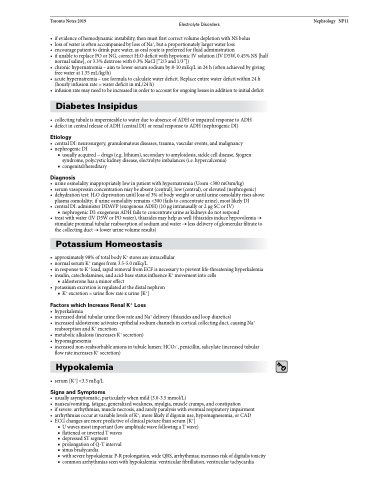Page 711 - TNFlipTest
P. 711
Toronto Notes 2019 Electrolyte Disorders Nephrology NP11
• ifevidenceofhemodynamicinstability,thenmustfirstcorrectvolumedepletionwithNSbolus
• lossofwaterisoftenaccompaniedbylossofNa+,butaproportionatelylargerwaterloss
• encouragepatienttodrinkpurewater,asoralrouteispreferredforfluidadministration
• ifunabletoreplacePOorNG,correctH2OdeficitwithhypotonicIVsolution(IVD5W,0.45%NS[half
normal saline], or 3.3% dextrose with 0.3% NaCl [“2/3 and 1/3”])
• chronichypernatremia–aimtolowerserumsodiumby8-10mEq/Lin24h(oftenachievedbygiving
free water at 1.35 mL/kg/h)
• acute hypernatremia – use formula to calculate water deficit. Replace entire water deficit within 24 h
(hourly infusion rate = water deficit in mL/24 h)
• infusionratemayneedtobeincreasedinordertoaccountforongoinglossesinadditiontoinitialdeficit
Diabetes Insipidus
• collectingtubuleisimpermeabletowaterduetoabsenceofADHorimpairedresponsetoADH
• defectincentralreleaseofADH(centralDI)orrenalresponsetoADH(nephrogenicDI)
Etiology
• centralDI:neurosurgery,granulomatousdiseases,trauma,vascularevents,andmalignancy • nephrogenicDI
■ usually acquired – drugs (e.g. lithium), secondary to amyloidosis, sickle cell disease, Sjogren syndrome, polycystic kidney disease, electrolyte imbalances (i.e. hypercalcemia)
■ congenital/hereditary
Diagnosis
• urineosmolalityinappropriatelylowinpatientwithhypernatremia(Uosm<300mOsm/kg)
• serumvasopressinconcentrationmaybeabsent(central),low(central),orelevated(nephrogenic)
• dehydrationtest:H2Odeprivationuntillossof3%ofbodyweightoruntilurineosmolalityrisesabove
plasma osmolality; if urine osmolality remains <300 (fails to concentrate urine), most likely DI • centralDI:administerDDAVP(exogenousADH)(10μgintranasallyor2μgSCorIV)
■ nephrogenic DI: exogenous ADH fails to concentrate urine as kidneys do not respond
• treatwithwater(IVD5WorPOwater),thiazidesmayhelpaswell(thiazidesinducehypovolemia→ stimulate proximal tubular reabsorption of sodium and water → less delivery of glomerular filtrate to
the collecting duct → lower urine volume results)
Potassium Homeostasis
• approximately 98% of total body K+ stores are intracellular
• normal serum K+ ranges from 3.5-5.0 mEq/L
• in response to K+ load, rapid removal from ECF is necessary to prevent life-threatening hyperkalemia • insulin, catecholamines, and acid-base status influence K+ movement into cells
■ aldosterone has a minor effect
• potassiumexcretionisregulatedatthedistalnephron
■ K+ excretion = urine flow rate x urine [K+]
Factors which Increase Renal K+ Loss
• hyperkalemia
• increased distal tubular urine flow rate and Na+ delivery (thiazides and loop diuretics)
• increasedaldosteroneactivatesepithelialsodiumchannelsincorticalcollectingduct,causingNa+
reabsorption and K+ excretion
• metabolic alkalosis (increases K+ secretion)
• hypomagnesemia
• increasednon-reabsorbableanionsintubulelumen:HCO3–,penicillin,salicylate(increasedtubular
flow rate increases K+ secretion)
Hypokalemia
• serum[K+]<3.5mEq/L
Signs and Symptoms
• usuallyasymptomatic,particularlywhenmild(3.0-3.5mmol/L)
• nausea/vomiting,fatigue,generalizedweakness,myalgia,musclecramps,andconstipation
• ifsevere:arrhythmias,musclenecrosis,andrarelyparalysiswitheventualrespiratoryimpairment • arrhythmiasoccuratvariablelevelsofK+;morelikelyifdigoxinuse,hypomagnesemia,orCAD • ECGchangesaremorepredictiveofclinicalpicturethanserum[K+]
■ U waves most important (low amplitude wave following a T wave) ■ flattened or inverted T waves
■ depressedSTsegment
■ prolongation of Q-T interval
■ sinus bradycardia
■ withseverehypokalemia:P-Rprolongation,wideQRS,arrhythmias;increasesriskofdigitalistoxicity ■ common arrhythmias seen with hypokalemia: ventricular fibrillation, ventricular tachycardia


